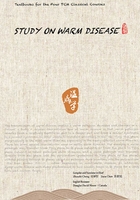
Instructions on Compilation and Translation
1.This book is for educational and browsing purposes, in other words, it is applicable to the students studying traditional Chinese medicine (TCM)in English at home and abroad. Therefore, it can be used as a higher text book for foreign students in Chinese universities or colleges of TCM, and also for students in TCM schools or college overseas. Besides, it is a popular book meant to be read by self-learning people, who may be experienced TCM practitioners, in order to improve their clinical proficiency, or people interested in the TCM classics only.
2.TCM classics are archaic and abstruse in language, and diversified and profound in meaning, thus they are very difficult for today’s people to understand all of their original texts. However, fortunately, the Study on Warm Disease (Wenbing Xue 温病学), as one of the texbooks for the four TCM classical courses, is greatly different from the other three books in structure and language expressions, namely, this book is compiled by means of modern medical textbook and with modern Chinese language,instead of the original archaic Chinese.
3.For the above mentioned reason, this book consists of two parts, the first part is a general exposition, and mainly discusses the concept, etiology,and pattern differentiation of commonly used diagnostic techniques,treatment and prevention of warm disease; the second part is a respective exposition, that concretely expounds the definition, etiology,pathogenesis, diagnostic key-points, therapeutic rules and basic formulas of 11 commonly seen warm diseases, which are ascribed to the following 4 kinds of warm diseases, i.e., dryness-heat, dampness-heat, warm toxin and pestilence.
4.The theoretical framework and basic academic thoughts, viewpoints and principles in this English textbook originate from the Chinese textbook with the same name, which comprehensively generalizes and summarizes the theoretical system and clinical experiences in the successive dynasties and refers to a lot of ancient medical works, especially, the medical books of warm disease in the Ming and Qing Dynasties.
5.The Chinese meanings of a part of the terms and phrases in a TCM specialty have different explanations at present, and only one meaning generally acknowledged is adopted in this book, but a few them are explained in accordance with the personal opinions by the compilers of the textbook. This is for decreasing the perplexities of learners or readers in understanding.
6.It is very hard to accurately translate TCM writings from Chinese into English, especially translating TCM classics, since there are no readymade corresponding words, phrases and sentences in English.Consequently, this book is translated from Chinese into English by means of taking free translation as a chief method, combined partly with wordfor-word translation and transliteration. Furthermore, free translation is based on a combination of both Chinese character denotation and TCM theories.
7.Transliteration in this book is applied with Chinese phonetic alphabet in italics. Generally speaking, transliteration should be used as litlle as possible. Only a minority of the terms and phrases in this book are difficultly translated into English, for example, and some specialized TCM vocabulary without corresponding English expressions, should be translated with the Chinese phonetic alphabet, such as Yin-Yang(阴阳), Qi(气), Sanjiao(三焦), Bianzheng Lunzhi(辨证论治), and the names of persons, books, dynasties, meridians, Chinese herbal medicines,formulas and acupoints. Moreover, some TCM terms are translated by combination of free translation and transliteration, e.g., Zangfu-organs(脏腑),upper-Jiao(上焦), Qi-transformation(气化), Wei phase pattern(Weifen Zhen 卫分证), Xue phase pattern(Xuefen Zheng 血分证)and so on.
8.When some basic or important terms and phrases appear first in this book, their English translation and Chinese characters may be displayed simultaneously so as to easily comprehend the real meanings of such English expressions. Afterward,one of the two English translations (free translations and transliteration) is used alone.
9.Some articles offer the relevant prescriptions which are mostly called as current formulas(Shifang 时方). Usually we introduce their ingredients and preparations when they appear first in the second part of the book, and after that,only the name of the same formula is mentioned. The practical doses of Chinese medicines in all formulas of this book should be commonly used clinically at present, and not the actual doses used in the original medical books, so as to make them more flexibly, according to patient’s specific condition, and also to decrease the readers’ difficulty in dose conversion. In order to cut down on the length of this book, the concrete doses, the methods of preparation, and the usage of all formulas were omitted.
10.To facilitate the study of readers, indexes of the main reference books, and the formulas used in this textbook, are listed at the end of the book. Besides, 11 diagrams of basic syndromes and their transmissions for 11 kinds of common warm diseases were made and placed in the relevant chapters, so as to help the learners to understand the different pathological laws of each warm disease.